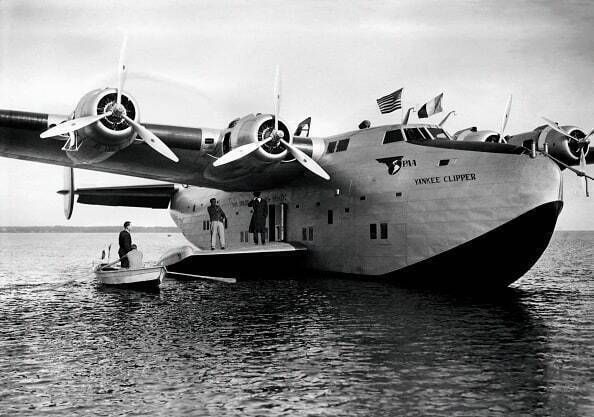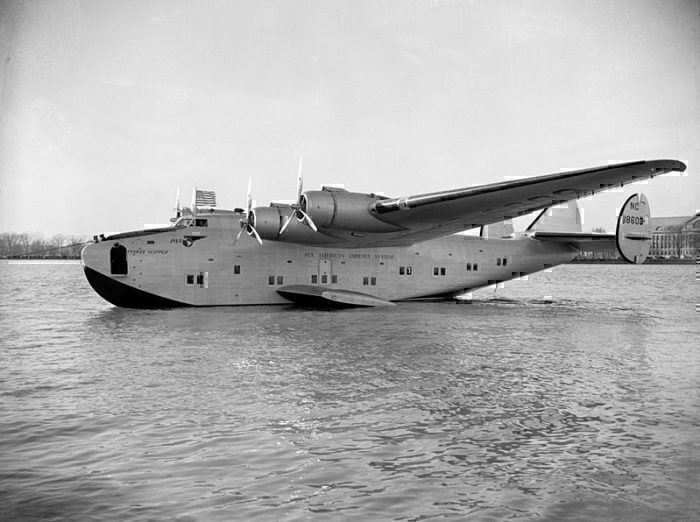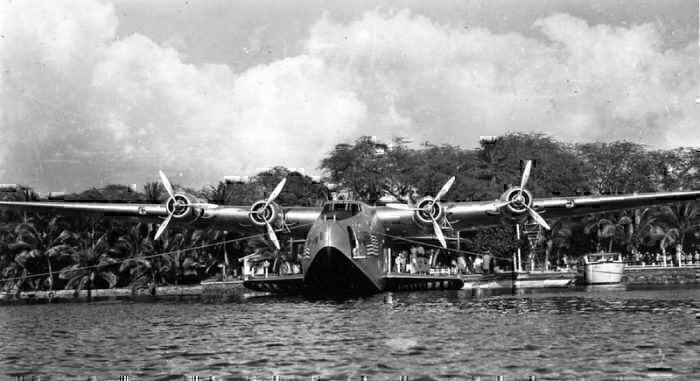If you thought that the golden age of air travel was in the 1950s and 1960s, you have obviously forgotten about the Pan Am Clipper and how it crossed the oceans. One of the largest aircraft of its time, the B-314 used a prototype wing designed for the Boeing XB-15 bomber to give it the ability to cross both the Atlantic and Pacific oceans.
Produced between 1938 and 1941, the Boeing 314 flying boat achieved more than any other aircraft of its time flying from the United States to the United Kingdom, Ireland, the Philippines, Guam, Australia, and New Zealand.
9 of 12 Boeing 314s built entered service with Pan Am
In total 12 aircraft were produced at the Boeing factory in Seattle, Washington, with nine entering service for Pan American World Airways. They were called Clippers after the mid-19th-century multi-mast sailing ships, which were designed for speed. Pan American’s flying boats were the pinnacle of luxury travel at the time.
At the time of their design just before the outbreak of World War II, very few cities had paved runways capable of accommodating large aircraft. By building a flying boat, Boeing produced a long-range plane that could land anywhere, providing the destination had a sheltered bay. Another key to the aircraft/boat was that in conditions where poor visibility would have prevented a conventional aircraft from landing, the Boeing 314 could land out at sea and then taxi into the harbor.
Multiple stops for long-distance journies
Built for luxury air travel due to the duration of transoceanic flights, seats on the Pan Am Clippers could be converted into beds for overnight accommodation somewhat similar to what we see in first and business class today. One of the huge differences between then and aircraft we are used to today was the fact that Pam Am Clippers had a cruising speed of just 188 miles per hour as opposed to the 560 miles per hour of a Boeing 777.
And, while the Clippers were capable of flying at 188 miles per hour, they typically only cruised over the ocean at a numbingly slow 155 miles per hour when fully loaded. This meant that a scheduled flight between San Francisco and Honolulu took 19 hours as opposed to the 5 hours and 40 minutes it takes planes to do the journey today.
Also, despite its ability to fly great distances, Pan Am would make scheduled stops on its Clipper transoceanic flights. Using the Southampton (UK) to New York route as an example, the Yankee Clipper would first stop in Foynes, Ireland, then Botwood, Newfoundland, and finally Shediac, New Brunswick before arriving in Port Washington, New York.
Almost exclusively the domain of the super-rich, a return ticket between New York and Southampton would cost $675- the equivalent of $12,000 today. With these prices, the Pan Am Clippers were more like up-market hotels than passenger aircraft.
On-board the aircraft, men and women were provided with separate dressing rooms and a dining room where white-gloved stewards served six-course silver-service meals prepared by top chefs hired from five-star hotels.
One of the beauties of the Pan American Clipper was that for the first time, rather than having to make a long sea voyage, it brought exotic Far Eastern destinations to air travel.
The first commercial aircraft to fly around the world
When England entered the war in September 1939, Pam American suspended its flights between America and Southampton but continued serving neutral Ireland and Portugal with flights to Foynes and Lisbon, respectively.
One of the most impressive accomplishments the Boeing 314 achieved was when the Pacific Clipper had just taken off from Honolulu as the Japanese launched their surprise attack on Pearl Harbor. Rather than returning to Hawaii and risk being shot down by a Japanese Mitsubishi A6M Zero, the Clipper was ordered to fly west to Auckland, New Zealand. Once safely in New Zealand, the aircraft was told to head west to New York, performing a 31,100-mile flight with stops in exotic places such as Surabaya (Indonesia), Karachi (Pakistan), Bahrain, Khartoum (Sudan), and Leopoldville in the Belgium Congo.
On the morning of January 6th, 1942, the Pacific Clipper landed at LaGuardia Field seaplane base with the distinction of being the first commercial aircraft to successfully circumnavigate the globe.
By the time the war ended in 1945 the need to land aircraft on the water was superfluous as aircraft could now land on concrete runways that were built to handle heavy bombers.
The last Pan American Airways World Airways Clipper retired in 1946 after having flown more than a million miles, ending what many consider to be one of the greatest eras of aviation.



